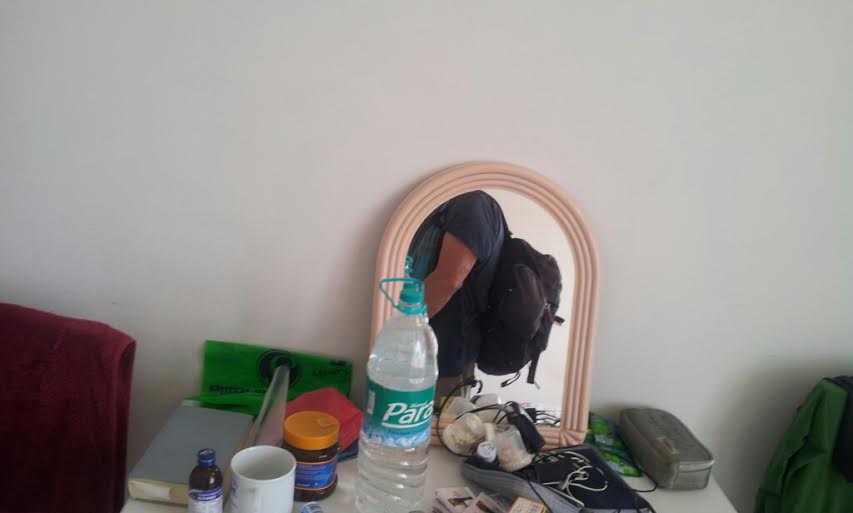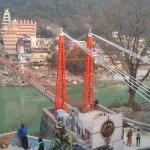Dit wordt, wellicht, voorlopig, naar het zich laat aanzien, de laatste blog for a while.
Er zijn nog een paar citaten uit het boek Guru and Disciple die ik wil delen.
En een anekdote, een verhaal dat de Swami van satsang om 4 vertelde over de schrijver van dat boek, die tevens een van de teachers was van de Swami, getuige dat de foto van Swami Abhishiktananda achter hem aan de muur hangt.
Links achter hem om precies te zijn. Rechts achter hem hangt een foto van nog een teacher waarvan ik de naam niet weet.
Het geheel voorafgegaan door de opmerking dat ikzelf iemand ben die altijd met een rugzakje om door de wereld stapt.
Hierboven een zelfportret met in mijn rugzak wel net die 4,5 kilo boeken die ik die dag ging laten inpakken en versturen.
Swami Abhishiktananda was overigens een Benedictijner monnik die als zendeling naar India vertrok in 1948 en daar, na eerst twee ontmoetingen met Ramana Maharshi, en tot zijn eigen verbazing, een guru vond, en veel later, na een hartaanval in Rishikesh, het Grote Licht zag.
De impact van het vinden van een goeroe bracht hem in een geloofscrisis:
He loved to stay in the caves of Arunachala. Yet, he was still lacking the specific relationship with a living guru.
In the Hindu tradition, the Advaitic mystery is communicated through a guru. This, however, is a delicate matter for a Christian. For a Hindu, the realized guru is God in human form whilst, for a Christian, God has become man only in Jesus. How can a Christian take anybody other than Jesus as his sadguru?
Abhishiktananda was thus facing a spiritual crisis. He was torn between his religious convictions as a Christian monk and the powerful attraction of Advaita, which he felt was an inner call.
He had received help from Harilal*, a disciple of Sri Ramana whom he had met in Tiruvannamalai, and also from the Parsi doctor Dinsha Mehta at Bombay, who was a medium to an inner voice which identified itself as Jesus Christ. But neither of them was the ultimate guru for Abhishiktananda.
According to Hindu tradition when a disciple is ready, the guru comes. It was at this point of crisis in his spiritual life that he came to meet Sri Gnanananda. It was truly an hour of God. It was the meeting of a very well qualified disciple with a sadguru, a living witness to the Upanishadic tradition.
footnote *
Sri H.W.L. Poonja (1910 – 1997) also known as ‘Poonjaji’ or ‘Papaji’ was a disciple of Sri Ramana Maharshi and the nephew of Swami Rama Thirtha. He became a renowned teacher of radical Advaita. His first meeting and interaction with Swami Abhishiktananda are narrated in Abhishiktananda, The secret of Arunachala, Delhi (ISPCK), 1997, pp 81-97.
Deze ontmoetingen speelden zich dus af in de jaren vijftig.
(Papaji zou later de teacher worden van mijn teacher Isaac Shapiro).
Tussendoor kan ik nog melden dat ik eergister dit noteerde:
Geslapen tot 8.20. Gedroomd. Ik had een schoonmaakbaan in een gebouw. Volgens een kaart moest ik een bepaald gedeelte schoonmaken. De ruimte is achter een zeker paneel. Om het gebouw heenlopend zie ik dat het de opslagkamer is van de kamer van het hoofd van de school. Ik voel angst om daar aan te kloppen.
Dit citaat is uit de preface van het boek, een mooie verhandeling over de ontmoeting tussen Oost en West:
Some people, the intellectuals, ask India for ideas. Ever since Plato, and especially since Aristotle, the Mediterranean world has lived under the domination of the eidos, that is, of thoughts and concepts. It only knows things by means of the concepts which it has fashioned of them. But, as has been so clearly shown both by psycho-analysis and by modern structuralism, all concepts, however abstract, as well as the value-judgements which accompany them, are inevitably marked by the basic structures which underlie our thinking–our archetypes, our habits of speech, in short, our whole conditioning through heredity and environment–apart from which, of course, no one can live or grow humanly or spiritually.
India’s grace is precisely that it makes us aware, at the deepest level, of this conditioning–these “knots of the heart”, as they are called in the Upanishads–by casting over the whole mental process the “shadow”, so to speak of the Unconditioned, which each of us bears at the very center of one’s being.
Indian logic certainly has no cause to feel inferior to medieval scholasticism when it comes to splitting hairs, and the speculative discussions between different schools in India yield nothing to those of European theologians. However, as soon as one looks a little closer, one realizes that these discussions do not touch what is essential and that the conflict of ideas is always like the waves which play on the surface of the sea; underneath are the depths, supporting everything, beyond all discussion, beyond the reach of any words, unaffected by anything, and yet the foundation of all. In India the umbilical cord has never been cut, which links the experience of depth, one and unique, with the multiplicity of forms in which it is reflected at the various levels of the mind.
Zo, dit stuk sleept zich voort en is inmiddels wel lang genoeg.
Dat betekent dat ik een prachtig maar lang citaat weglaat. En zo ook de beloofde anekdote. Genoeg is genoeg.
Ik verhuis vandaag een brug. Ik was zeg maar een brug te ver geland en nu ga ik naar rmijn favoriete brug: de Laxman Jhula.
Maar eerst voor de grap nog een plaatje en een link naar een website. En daarna deze .









Laatste blok.
Hans .
Betekent dat ook dat je je laatste weken ingaat?
De brug in Laks man juhla heb ik wel herrinnering aan en wekt heimwee bij me op.
Heb nog een Mooier tijd verder